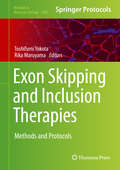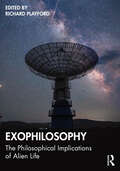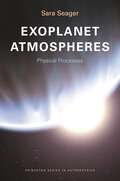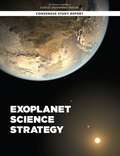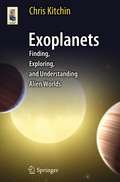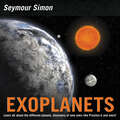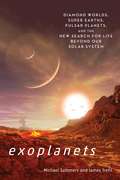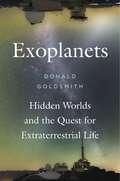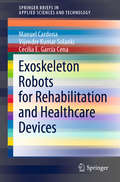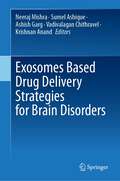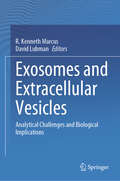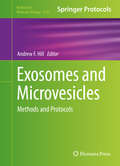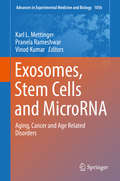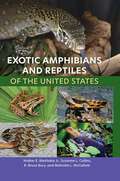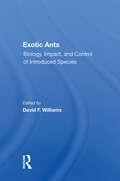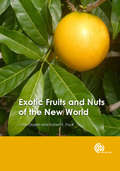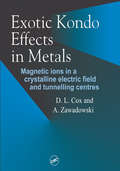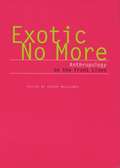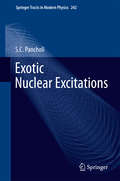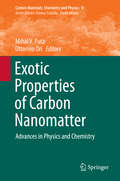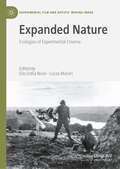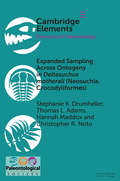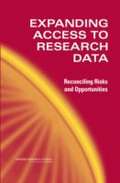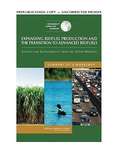- Table View
- List View
Exon Skipping and Inclusion Therapies: Methods And Protocols (Methods in Molecular Biology #1828)
by Toshifumi Yokota Rika MaruyamaThis book presents a comprehensive collection of detailed state-of-the-art exon skipping and splices modulation protocols. Chapters detail 14 genetic diseases, AON-mediated therapies, and CRISPR/Cas9-mediated gene editing therapies. Written in the highly successful Methods in Molecular Biology series format, chapters include introductions to their respective topics, lists of the necessary materials and reagents, step-by-step, readily reproducible laboratory protocols, and tips on troubleshooting and avoiding known pitfalls. Authoritative and cutting-edge, Exon Skipping and Inclusion Therapies: Methods and Protocols aims to help researchers initiate the development of next-generation therapies.
Exophilosophy: The Philosophical Implications of Alien Life
by Richard PlayfordThis volume addresses philosophical questions raised by the possibility of alien life and extraterrestrial intelligence. The different philosophical perspectives and approaches presented across the chapters will provide a foundation for future work on exophilosophy.Interest in space, space exploration, and alien life has never been greater. In popular culture, for example, it has proven a persistent theme in science fiction films (e.g., Star Trek, Star Wars), books (e.g., H. G. Wells, Arthur C. Clarke, Ray Bradbury), and computer games (e.g., Sid Meier’s Alpha Centauri), as well as bestselling ‘non- fiction’ books (von Däniken’s multimillion-selling Chariots of the Gods?), and hit ‘documentary’ shows (e.g., Ancient Aliens). There has also been persistent interest in these topics amongst scientists with organizations such as NASA and SETI having an enormous impact on both the scientific and popular imagination. Yet, curiously, the topic has received relatively little philosophical attention. Whilst certain aspects of these topics remain within the proper purview of the sciences, a host of philosophical questions are raised by the possibility of alien life and extraterrestrial intelligences, and the possibility of our coming into contact with them. This collection of essays will examine some of these questions whilst laying the groundwork for future study in an as-yet under-researched area of philosophy.Exophilosophy is essential reading for scholars and students with an interest in space and philosophy, especially those working in philosophy of science, metaphysics, epistemology, ethics, philosophy of language, and philosophy of religion.
Exoplanet Atmospheres: Physical Processes (Princeton Series in Astrophysics #18)
by Sara SeagerOver the past twenty years, astronomers have identified hundreds of extrasolar planets--planets orbiting stars other than the sun. Recent research in this burgeoning field has made it possible to observe and measure the atmospheres of these exoplanets. This is the first textbook to describe the basic physical processes--including radiative transfer, molecular absorption, and chemical processes--common to all planetary atmospheres, as well as the transit, eclipse, and thermal phase variation observations that are unique to exoplanets. In each chapter, Sara Seager offers a conceptual introduction, examples that combine the relevant physics equations with real data, and exercises. Topics range from foundational knowledge, such as the origin of atmospheric composition and planetary spectra, to more advanced concepts, such as solutions to the radiative transfer equation, polarization, and molecular and condensate opacities. Since planets vary widely in their atmospheric properties, Seager emphasizes the major physical processes that govern all planetary atmospheres. Moving from first principles to cutting-edge research, Exoplanet Atmospheres is an ideal resource for students and researchers in astronomy and earth sciences, one that will help prepare them for the next generation of planetary science. The first textbook to describe exoplanet atmospheres Illustrates concepts using examples grounded in real data Provides a step-by-step guide to understanding the structure and emergent spectrum of a planetary atmosphere Includes exercises for students
Exoplanet Science Strategy
by Engineering Medicine National Academies of SciencesThe past decade has delivered remarkable discoveries in the study of exoplanets. Hand-in-hand with these advances, a theoretical understanding of the myriad of processes that dictate the formation and evolution of planets has matured, spurred on by the avalanche of unexpected discoveries. Appreciation of the factors that make a planet hospitable to life has grown in sophistication, as has understanding of the context for biosignatures, the remotely detectable aspects of a planet’s atmosphere or surface that reveal the presence of life. Exoplanet Science Strategy highlights strategic priorities for large, coordinated efforts that will support the scientific goals of the broad exoplanet science community. This report outlines a strategic plan that will answer lingering questions through a combination of large, ambitious community-supported efforts and support for diverse, creative, community-driven investigator research.
Exoplanets
by C. R. KitchinExoplanets: Finding, Exploring, and Understanding Alien Worlds probes the basis for possible answers to the fundamentals questions asked about these planets orbiting stars other than our Sun. This book examines what such planets might be like, where they are, and how we find them. Until around ten years ago, the only planets that we knew about were within the Solar System. The first genuine planet beyond the confines of the Solar System was discovered only 1988. Since then another 350 or so exoplanets have been detected by various methods, and most of these haven been found in the last ten years. Although many more exoplanets discoveries may be expected to occur even as this book is being read, a large enough data set is now available to form the basis for an informed general account of exoplanets. The topic hence is an extremely "hot" one - all the more so because the recently launched Kepler spacecraft should soon start uncovering many more exoplanets, some perhaps comparable with the Earth (and therefore possibly alternative homes for mankind, if we could ever reach them). Exoplanets: Finding, Exploring, and Understanding Alien Life gives a comprehensive, balances, and above all accurate account of exoplanets.
Exoplanets
by Seymour SimonAward-winning science writer Seymour Simon explores the farthest reaches of space in the brand-new Exoplanets! This nonfiction picture book is an excellent choice to share during homeschooling, in particular for children ages 6 to 8. It’s a fun way to learn to read and as a supplement for activity books for children.There are thousands of exoplanets scattered throughout the Milky Way galaxy, and scientists are on a constant quest to find one just like Earth. In Exoplanets, Simon examines the planets outside of our solar system and uncovers what makes them habitable, our efforts to discover new life, and more.With clear, simple text and stunning full-color photographs, readers will explore the farthest reaches of space and explore the answer to the question: do aliens exist?This book includes an author's note, a glossary, an index, and supports the Common Core State Standards.
Exoplanets: Diamond Worlds, Super Earths, Pulsar Planets, and the New Search for Life beyond Our Solar System
by James Trefil Michael E. SummersThe past few years have seen an incredible explosion in our knowledge of the universe. Since its 2009 launch, the Kepler satellite has discovered more than two thousand exoplanets, or planets outside our solar system. More exoplanets are being discovered all the time, and even more remarkable than the sheer number of exoplanets is their variety. In Exoplanets, astronomer Michael Summers and physicist James Trefil explore these remarkable recent discoveries: planets revolving around pulsars, planets made of diamond, planets that are mostly water, and numerous rogue planets wandering through the emptiness of space. This captivating book reveals the latest discoveries and argues that the incredible richness and complexity we are finding necessitates a change in our questions and mental paradigms. In short, we have to change how we think about the universe and our place in it, because it is stranger and more interesting than we could have imagined.
Exoplanets: Hidden Worlds and the Quest for Extraterrestrial Life
by Donald GoldsmithAstronomers have recently discovered thousands of exotic planets that orbit stars throughout our Milky Way galaxy. With his characteristic wit and style, Donald Goldsmith shows how these observations have already broadened our planetary horizons, and tells us what may come next, including the ultimate discovery: life beyond our home planet.
Exoskeleton Robots for Rehabilitation and Healthcare Devices (SpringerBriefs in Applied Sciences and Technology)
by Vijender Kumar Solanki Manuel Cardona Cecilia E. García CenaThis book addresses cutting-edge topics in robotics and related technologies for rehabilitation, covering basic concepts and providing the reader with the information they need to solve various practical problems. Intended as a reference guide to the application of robotics in rehabilitation, it covers e.g. musculoskeletal modelling, gait analysis, biomechanics, robotics modelling and simulation, sensors, wearable devices, and the Internet of Medical Things.
Exosomes Based Drug Delivery Strategies for Brain Disorders
by Krishnan Anand Neeraj Mishra Sumel Ashique Ashish Garg Vadivalagan ChithravelThis book provides a comprehensive overview of the role of exosomes in brain diseases, including stroke, multiple sclerosis, Parkinson's disease, Alzheimer's disease, epilepsy, and depression. It covers the basics of exosome biogenesis, composition, and synthesis, as well as the therapeutic potential of exosomes in brain disorders. The correlation between exosomes and neuroinflammation, the challenges of using exosomes as a novel carrier, and engineered exosomes to deliver therapeutic protein are covered well in this book. Use of radiolabelled exosomes as a diagnostic tool and the toxicity studies of exosomes with potential overcome approaches. It is an essential resource for researchers, clinicians, and healthcare professionals working in the field of exosome research, especially on its applications in brain disorders.
Exosomes and Extracellular Vesicles: Analytical Challenges and Biological Implications
by R. Kenneth Marcus David LubmanThis book introduces a comprehensive overview of exosomes in biology for their roles in cell signalling. This edited collection of works by leading extracellular vesicle (EV) scientists and medical professionals introduces readers to various aspects of the rapidly expanding field of exosomes and extracellular vesicles. Contributing authors pay close attention to the analytical techniques and methods in this field, with a particular focus on mass spectrometry. The chapters cover areas including biological and therapeutic significance, novel methods for isolation of these EVs from human body fluids and cell culture media, and examples of their use in biomarker research and in therapeutic applications. This book provides an expert analysis of the latest advances in this field, including the isolation of EVs and their various applications. The highlighted chapters provide readers a broad overview of the relevant analytical challenges in EV science. This book is of interest to both scientific researchers and medical practitioners, as well as graduate students in diverse areas of fundamental biology, physiology, medicine, pharmaceuticals, and analytical chemistry.
Exosomes and Microvesicles
by Andrew F. HillThis volume covers methods for the analysis of extracellular vesicles (EV) that can be applied to isolated EVs from a wide variety of sources. This includes the use of electron microscopy, tunable resistance pulse sensing, and nanoparticle tracking analysis. The chapters in this book discuss EV cargoes containing proteins and genomic materials using a number of different approaches, and isolating EVs from platelets and neuronal cells and tissues. Written in the highly successful Methods in Molecular Biology series format, chapters include introductions to their respective topics, lists of the necessary materials and reagents, step-by-step, readily reproducible laboratory protocols, and tips on troubleshooting and avoiding known pitfalls. Practical and comprehensive, Exosomes and Microvesicles: Methods and Protocols is a valuable resource containing methodologies for anyone interested in researching EVs.
Exosomes, Stem Cells and MicroRNA: Aging, Cancer And Age Related Disorders (Advances In Experimental Medicine And Biology #1056)
by Vinod Kumar Pranela Rameshwar Karl L. MettingerThis volume provides insight into the pivotal roles of stem cells, exosomes and other microvesicles in biofunction and molecular mechanisms and their therapeutic potential in translational nanomedicine. It further highlights evidence from recent studies as to how stem cell derived exosomes and microRNAs may restore and maintain tissue homeostasis, enable cells to recover critical cellular functions and begin repair regeneration. These early studies in animal models of aging also show evidence of improved immune, cardiovascular and cognitive functions as well as improved health span and life span. The use of exosomes from body fluids to define specific biomarkers for various tumors may also clear the path to patient-targeted treatments by developing exosome-derived microRNA based cancer therapeutics. It is essential reading for graduate students, research fellow and biomedical researchers in academia or the pharmaceutical or biotech industries.
Exotic Amphibians and Reptiles of the United States
by Walter E. Meshaka Jr. Suzanne L. Collins R. Bruce Bury Malcolm L. McCallumThe first complete field guide to the exotic amphibians and reptiles established in the continental United States and Hawaiʻi, this volume covers 74 species that are not native to the country and 29 species that are native but occur beyond their original geographic range. Dispersed from their former habitats by human activity, many of these species are invasive in their new environments, causing ecological or economic harm. Ideal for naturalists of all levels, Exotic Amphibians and Reptiles of the United States details each species’ taxonomy, distribution, history, and ecology and portrays each one with vibrant photographs. Drawing on county-level distribution maps from 2,908 published records, this guide provides an in-depth understanding of local factors that drive the success of exotic species. It connects species-specific information to conservation issues as it explores human causes of exotic and invasive establishment. The book also includes eight invited essays which provide regional perspectives on scientific, economic, and management-related aspects of this phenomenon. As ecological pressures on native species and habitats increase, understanding the histories and roles of exotic species is becoming more and more important for conservation efforts. Providing practical identification skills and an awareness of the environmental impacts of these amphibians and reptiles, this indispensable guide equips readers to confront the unusual biodiversity crisis of exotic species.
Exotic Ants: Biology, Impact, And Control Of Introduced Species
by David F WilliamsOriginally published in 1994, this volume presents research findings from experts on introduced pest ant species.
Exotic Fruits and Nuts of the New World
by Robert E Paull Odilo DuarteA major reference work on exotic and underutilised fruits and nuts of the New World. While many of these are well known in the local markets and in Spanish-language literature, they have rarely been brought to the attention of the wider English-speaking audience, and as such this book will offer an entirely new resource to those interested in exotic crops.
Exotic Fruits and Nuts of the New World
by Robert E Paull Odilo DuarteA major reference work on exotic and underutilised fruits and nuts of the New World. While many of these are well known in the local markets and in Spanish-language literature, they have rarely been brought to the attention of the wider English-speaking audience, and as such this book will offer an entirely new resource to those interested in exotic crops.
Exotic Kondo Effects in Metals: Magnetic Ions in a Crystalline Electric Field and Tunelling Centres
by D L Cox A ZawadowskiThis provides a major review of the two-level system Kondo model, as applied to metallic glasses, nanoscale devices and some doped semiconductors; and the quadripolar and magnetic two-channel Kondo models developed for rare-earth and actinide ions with crystal splitting metals. These contrast with the simple single-channel model, and allow the study of non-Fermi liquid physics. This book forms a valuable and unique source of information for statistical and condensed matter physicists and graduate students.Key Features: * An invaluable and unique source of information on this highly popular area of condensed matter physics* Based upon a special edition of the Advances in Physics journal* Magnetic impurities in metals present a major challenge to condensed matter physicists, for which a strong starting point has long been the early insights of Kondo into the resistance medium
Exotic No More: Anthropology on the Front Lines
by Jeremy MacclancySince its founding in the nineteenth century, social anthropology has been seen as the study of exotic peoples in faraway places. But today more and more anthropologists are dedicating themselves not just to observing but to understanding and helping solve social problems wherever they occur--in international aid organizations, British TV studios, American hospitals, or racist enclaves in Eastern Europe, for example.
Exotic Nuclear Excitations
by S. C. PancholiBy providing the reader with a foundational background in high spin nuclear structure physics and exploring exciting current discoveries in the field, this book presents new phenomena in a clear and compelling way. The quest for achieving the highest spin states has resulted in some remarkable successes which this monograph will address in comprehensive detail. The text covers an array of pertinent subject matter, including the rotational alignment and bandcrossings, magnetic rotation, triaxial strong deformation and wobbling motion and chirality in nuclei. This book offers a clearly-written and up-to-date treatment of the topics covered. The prerequisites for a proper appreciation are courses in nuclear physics and nuclear models and measurement techniques of observables like gamma-ray energies, intensities, multi-fold coincidences, angular correlations or distributions, linear polarization, internal conversion coefficients, short lifetime (pico-second range) of excited states etc. and instrumentation and data analysis methods.
Exotic Properties of Carbon Nanomatter
by Mihai V. Putz Ottorino OriThis title reports the state-of-the-art advancements in modeling and characterization of fundamental and the recently designed carbon based nanocomposites (graphenes, fullerenes, polymers, crystals and allotropic forms). Written by leading experts in the field, the book explores the quantification, indexing, and interpretation of physical and chemical exotic properties related with space-time structure-evolution, phase transitions, chemical reactivity, and topology. Exotic Properties of Carbon Nanomatter is aimed at researchers in academia and industry.
Expanded Nature: Écologies du cinéma expérimental (Experimental Film and Artists’ Moving Image)
by Elio Della Noce Lucas MurariThis book explores the emergence of ecological consciousness in the work of contemporary experimental filmmakers. If it can be said that experimental filmmakers are "expanding" the artistic field through an exploration of the potencies, modes of dissemination and performance of the moving image, in the Anthropocene these practices strive for another kind of expansion: to expand our experience of nature. Appending flowers to the film strip or burying it in the ground, inventing observational devices, allowing the camera to be affected by natural forces, engaging one's own filming body in a symbiotic relationship with the environment, reconstituting ecosystems at the moment of projection: the ecologies of experimental cinema presented in this book constitute forms of practice and engagement that awaken a heightened sensibility towards the living world through cooperative links, casting other beings as subjects and agents of filmic processes, and, finally, reshaping the economy of filmmaking. Thus, ecologies of perception, medium, production, and multinaturalism are deployed, contributing to the restoration of our sensory bond with the natural world. Several chapters were translated with the help of artificial intelligence. In each case, the text has subsequently been revised further by the author as well as the translator Charlie Hewison and a professional copy editor.
Expanded Sampling Across Ontogeny in Deltasuchus motherali: Revealing Ecomorphological Niche Partitioning and Appalachian Endemism in Cenomanian Crocodyliforms (Elements of Paleontology)
by Stephanie K. Drumheller Thomas L. Adams Hannah Maddox Christopher R. NotoNew material attributable to Deltasuchus motherali, a neosuchian from the Cenomanian of Texas, provides sampling across much of the ontogeny of this species. Detailed descriptions provide both information about the paleobiology of this species, particularly with regards to how growth and development affected diet. Overall snout shape became progressively wider and more robust with age, suggesting that dietary shifts from juvenile to adult were not only a matter of size change, but functional performance as well. These newly described elements provide additional characters upon which to base more robust phylogenetic analyses. The authors provide a revised diagnosis of this species, describing the new material and discussing incidents of apparent ontogenetic variation across the sampled population. The results of the ensuing phylogenetic analyses both situate Deltasuchus within an endemic clade of Appalachian crocodyliforms, separate and diagnosable from goniopholidids and pholidosaurs, herein referred to as Paluxysuchidae.
Expanding Access to Research Data: Reconciling Risks and Opportunities
by Panel on Data Access for Research PurposesPolicy makers need information about the nation—ranging from trends in the overall economy down to the use by individuals of Medicare—in order to evaluate existing programs and to develop new ones. This information often comes from research based on data about individual people, households, and businesses and other organizations, collected by statistical agencies. The benefit of increasing data accessibility to researchers and analysts is better informed public policy. To realize this benefit, a variety of modes for data access— including restricted access to confidential data and unrestricted access to appropriately altered public-use data—must be used. The risk of expanded access to potentially sensitive data is the increased probability of breaching the confidentiality of the data and, in turn, eroding public confidence in the data collection enterprise. Indeed, the statistical system of the United States ultimately depends on the willingness of the public to provide the information on which research data are based. Expanding Access to Research Data issues guidance on how to more fully exploit these tradeoffs. The panel’s recommendations focus on needs highlighted by legal, social, and technological changes that have occurred during the last decade.
Expanding Biofuel Production and the Transition to Advanced Biofuels: Lessons for Sustainability from the Upper Midwest
by National Research Council of the National AcademiesWhile energy prices, energy security, and climate change are front and center in the national media, these issues are often framed to the exclusion of the broader issue of sustainability--ensuring that the production and use of biofuels do not compromise the needs of future generations by recognizing the need to protect life-support systems, promote economic growth, and improve societal welfare. Thus, it is important to understand the effects of biofuel production and use on water quality and quantity, soils, wildlife habitat and biodiversity, greenhouse gas emissions, air quality, public health, and the economic viability of rural communities.
